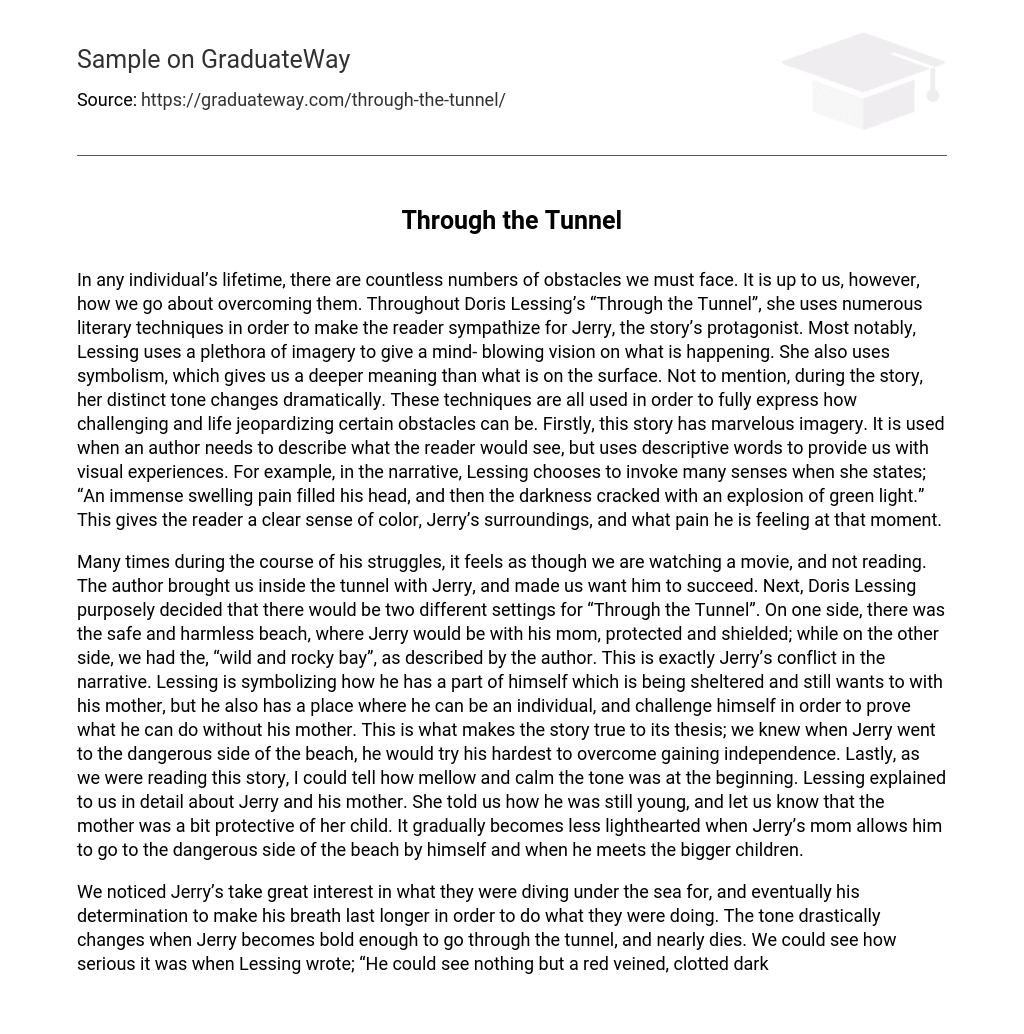In any individual’s lifetime, there are countless numbers of obstacles we must face. It is up to us, however, how we go about overcoming them. Throughout Doris Lessing’s “Through the Tunnel”, she uses numerous literary techniques in order to make the reader sympathize for Jerry, the story’s protagonist. Most notably, Lessing uses a plethora of imagery to give a mind- blowing vision on what is happening. She also uses symbolism, which gives us a deeper meaning than what is on the surface. Not to mention, during the story, her distinct tone changes dramatically. These techniques are all used in order to fully express how challenging and life jeopardizing certain obstacles can be. Firstly, this story has marvelous imagery. It is used when an author needs to describe what the reader would see, but uses descriptive words to provide us with visual experiences. For example, in the narrative, Lessing chooses to invoke many senses when she states; “An immense swelling pain filled his head, and then the darkness cracked with an explosion of green light.” This gives the reader a clear sense of color, Jerry’s surroundings, and what pain he is feeling at that moment.
Many times during the course of his struggles, it feels as though we are watching a movie, and not reading. The author brought us inside the tunnel with Jerry, and made us want him to succeed. Next, Doris Lessing purposely decided that there would be two different settings for “Through the Tunnel”. On one side, there was the safe and harmless beach, where Jerry would be with his mom, protected and shielded; while on the other side, we had the, “wild and rocky bay”, as described by the author. This is exactly Jerry’s conflict in the narrative. Lessing is symbolizing how he has a part of himself which is being sheltered and still wants to with his mother, but he also has a place where he can be an individual, and challenge himself in order to prove what he can do without his mother. This is what makes the story true to its thesis; we knew when Jerry went to the dangerous side of the beach, he would try his hardest to overcome gaining independence. Lastly, as we were reading this story, I could tell how mellow and calm the tone was at the beginning. Lessing explained to us in detail about Jerry and his mother. She told us how he was still young, and let us know that the mother was a bit protective of her child. It gradually becomes less lighthearted when Jerry’s mom allows him to go to the dangerous side of the beach by himself and when he meets the bigger children.
We noticed Jerry’s take great interest in what they were diving under the sea for, and eventually his determination to make his breath last longer in order to do what they were doing. The tone drastically changes when Jerry becomes bold enough to go through the tunnel, and nearly dies. We could see how serious it was when Lessing wrote; “He could see nothing but a red veined, clotted dark. His eyes must have burst.” It takes an incredible author to manage such powerful literary techniques in their works, but that is what made this story so inspirational. Jerry, this young boy, managed to overcome his obstacle, and nearly died trying to accomplish it. He was able to transition from childhood, to adulthood. Without Lessing’s use of imagery, symbolism, or tone, the story wouldn’t be as heartwarming. We wouldn’t be able to feel what Jerry had to go through in order to get through that tunnel, or understand the severity of the situation he was in. She went beyond just writing down a story on a piece of paper, and made it something much more.





